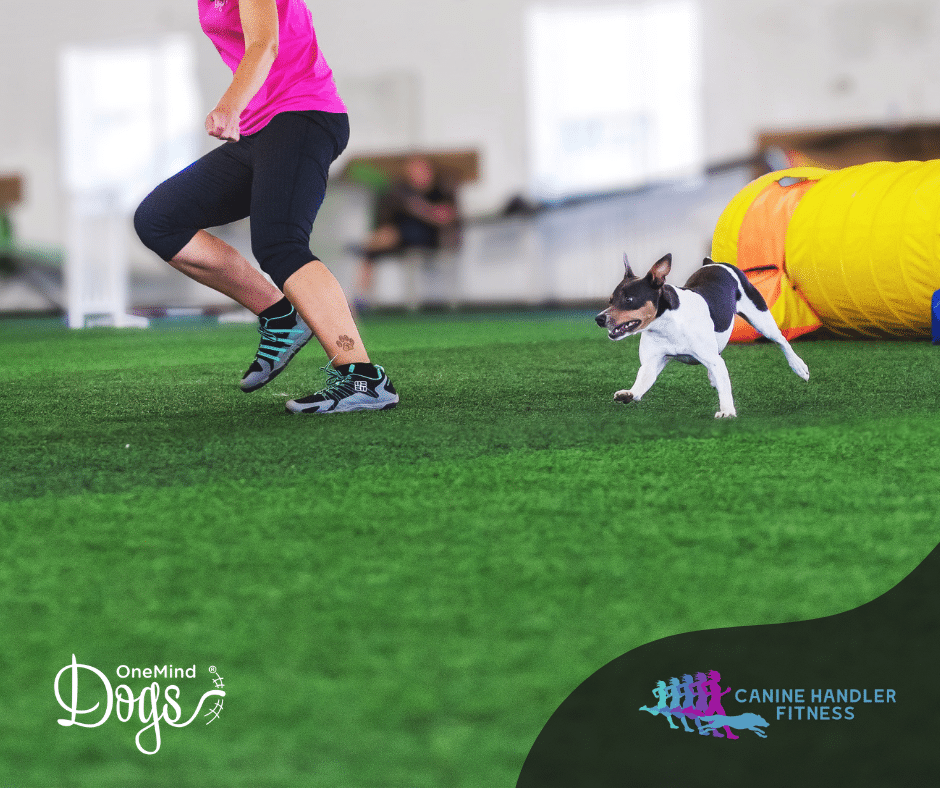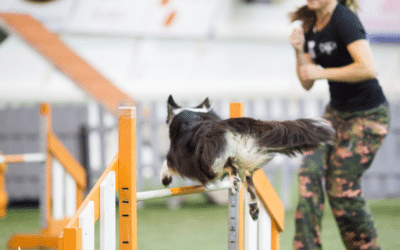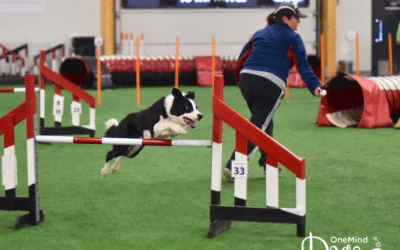Dog agility handlers come in all shapes and sizes, there are no barriers to playing agility with your dog! At OneMind Dogs we believe that agility is one of the most inclusive sports in the world and that everyone should play agility games with their dogs! Having said that, if you would like to compete in agility (or you already do) then it won’t hurt to look into your strength, fitness and mobility, to make sure that you’re preparing yourself for the adrenaline-fuelled sport of agility competition!
Fitness doesn’t always mean focusing on running faster. While this is a great side benefit of handler fitness, there are many other benefits that will impact both sides of the team! Being fit will help you to achieve a strong and balanced body so that you can focus on connecting with your dog and executing your handling.
The other main benefit of handler fitness is injury prevention! We all work so hard on keeping our teammates in their best possible condition, it’s time we do this for ourselves as well.
If you improve your strength and fitness even by a small amount, it’ll feel easier to run your dog and to focus on handling and connection during your runs.
So how do you get fit for agility?
Are you unsure where to start with your fitness regime? Don’t worry, you’re not alone! Join Liz Joyce from Canine Handler Fitness Ltd. as she walks us through her favorite way to improve handler speed and fitness!
Liz says: “Speed is the number one thing that agility athletes come to me to work on and I’m excited to talk to you about two common, and impactful, areas for improvement.
You’re going to learn some tools that will improve your sprinting mechanics and speed. Without good sprinting mechanics, the speed doesn’t follow.
What I’m going to show you right now, and what I want you to take from it when you’re watching this, is how much a person’s speed can improve with a focused effort on their form and mechanics.”
This is completely possible and you can do it too!
The two areas Liz will discuss today are knee height and foot strike position.
Knee height
Liz explains “We are going to talk about knee height first. When you drive your knee higher and you’re sprinting, it maximizes your power development. If you lift your knees higher, you’re going to be able to apply a greater force to the ground which is going to enable you to push off harder.
You could think about your knee like a hammer and you’re hammering a nail into a board. The harder you hit the hammer onto the nail, the deeper and faster that nail is going go into the board.
In that same way, the higher the knee goes, the harder the foot can hit the ground. And actually, that analogy of hitting a nail into the ground underneath you is a great way to picture making good contact with your foot into the ground and creating that really powerful movement that we’re looking for.
With a little practice under your belt, the knee driving up creates a bit of height and buoyancy off the ground.”
Okay, so how do you pattern really good knee height?
Here are some drills that Liz has used successfully with hundreds of people. Aim for 30 seconds a side:
What I’d love you to do is almost over-correct your knee height. Practice HEIGHT. I’ll tell you right now that with the excitement you experience in the competition ring, combined with a focus on handling your dog, your knee height is naturally going to drop. “Train hard, trial easy.”
Mobility for movement
Liz emphasizs that: “One thing that can affect adequate knee height drive is mobility. These are my favourite ways to build the mobility you need for this movement. Aim for 30-60 seconds per side.”
Foot strike position
Ideally, when sprinting, the foot will land directly below you, on the forefoot. When you’re jogging it’s mid-foot, and when walking your heel will touch first.
Liz explains “Heel striking is when the foot extends in front and you touch the ground first with your heel. We don’t like heel striking for sprinting. Heel striking when sprinting slows you down and is hard on your joints.
As a species, we are not designed to be landing on our heels when sprinting but modern footwear with its dense foam heel makes this possible without discomfort. The dense foam absorbs the impact and if you were to take your shoes off (please don’t, just trust me here) and try to sprint with heel striking there is no way your body would allow it. It hurts too much!
It’s also not an ideal landing position from a ‘pushing off to the next stride’ perspective. When you land on the forefoot you can seamlessly pull the knee into the next stride. If you land on your heel you’ve got a distance to rock over before you’re in a position to push off again. Major loss of efficiency and power.”
Liz has designed some drills which are going to help you connect with where you should be landing on your feet when you’re sprinting, which is more the ball of your foot.
Let’s practice!
Liz has an exercise for you to try: “What I’d love for you to do is film yourself 30-50 meters from the camera. You’ll want to catch a side view. With this new information, examine your stride.
Are you knees lifting to approximately your hip height? Are your heels striking first? Analyzing your video will help you decide which of these two areas you need to work on.”
If you’d like to create a workout from Liz’s great exercises shown in the videos above, she has given an example of what it would look like in a workout format:
- Dynamic stretches 30-60 secs/side
- Warm up with a light jog or power walk 3-5 mins
- Foot strike drills 30 secs/side
- Knee height drills 30 secs/side
- Sprint 30-100 meters, 2-4 times. Rest as needed between runs. You should feel fairly fresh before you head into your next sprint.
Liz always focuses on the mental side of fitness too:
Most important of all, be your biggest cheerleader! There are a lot of big feelings when it comes to our bodies. All of us. And especially when we’re trying new things! You’ve got this!!
Are you keen to learn more? Have a look at our Handler Fitness theme on the OneMind Dogs learning platform and try the 4-pillar fitness audit!



